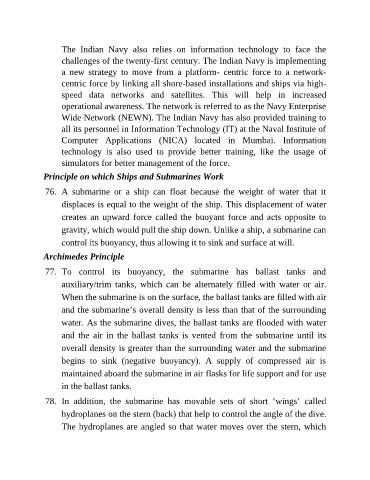Page 309 - SSB Interview: The Complete Guide, Second Edition
P. 309
The Indian Navy also relies on information technology to face the
challenges of the twenty-first century. The Indian Navy is implementing
a new strategy to move from a platform- centric force to a network-
centric force by linking all shore-based installations and ships via high-
speed data networks and satellites. This will help in increased
operational awareness. The network is referred to as the Navy Enterprise
Wide Network (NEWN). The Indian Navy has also provided training to
all its personnel in Information Technology (IT) at the Naval Institute of
Computer Applications (NICA) located in Mumbai. Information
technology is also used to provide better training, like the usage of
simulators for better management of the force.
Principle on which Ships and Submarines Work
76. A submarine or a ship can float because the weight of water that it
displaces is equal to the weight of the ship. This displacement of water
creates an upward force called the buoyant force and acts opposite to
gravity, which would pull the ship down. Unlike a ship, a submarine can
control its buoyancy, thus allowing it to sink and surface at will.
Archimedes Principle
77. To control its buoyancy, the submarine has ballast tanks and
auxiliary/trim tanks, which can be alternately filled with water or air.
When the submarine is on the surface, the ballast tanks are filled with air
and the submarine’s overall density is less than that of the surrounding
water. As the submarine dives, the ballast tanks are flooded with water
and the air in the ballast tanks is vented from the submarine until its
overall density is greater than the surrounding water and the submarine
begins to sink (negative buoyancy). A supply of compressed air is
maintained aboard the submarine in air flasks for life support and for use
in the ballast tanks.
78. In addition, the submarine has movable sets of short ‘wings’ called
hydroplanes on the stern (back) that help to control the angle of the dive.
The hydroplanes are angled so that water moves over the stern, which

